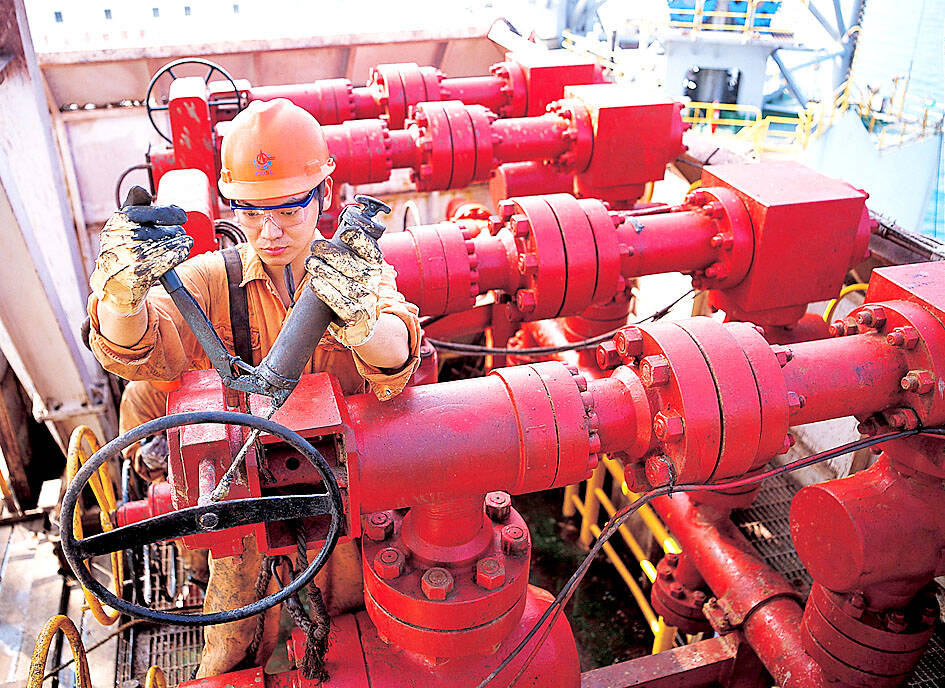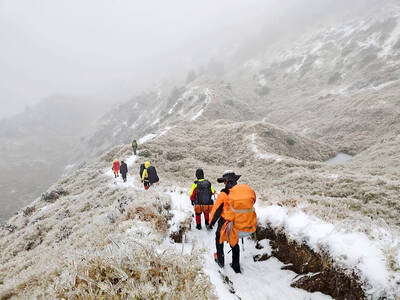Chinese oil rigs have been sighted just 26 nautical miles (42km), from Taiwan’s exclusive economic zone (EEZ) near Pratas Island (Dongsha Island, 東沙島), posing a threat to Taiwan’s sovereignty if left unchallenged, a brief published by the Jamestown Foundation on Tuesday said.
Pratas Island, 444km from Kaohsiung, is northeast of the South China Sea and houses a Taiwanese garrison.
The brief, titled “Rigging the Game: PRC Oil Structures Encroach on Taiwan’s Pratas Island” — referring to the People’s Republic of China — analyzed photographs and said that Beijing’s tools to pressure Taiwan now include oil rigs.

Photo: Reuters
“Oil rigs now constitute part of Beijing’s multidimensional campaign to undermine Taiwan’s sovereignty,” the report read.
There were 12 permanent or semi-permanent structures controlled by the Chinese state-owned China National Offshore Oil Corp (CNOOC) located near Pratas Island’s EEZ, it said.
“Intruding rigs that exploit natural resources without permission typify maritime gray zone operations conducted by the People’s Republic of China,” it said.
The rigs’ construction, extant since at least May 2020, demonstrates that China “rejects Taiwan’s jurisdiction” by building in areas where Taipei demands explicit permission to “construct, use, modify, or dismantle artificial islands, installations or structures,” it said.
CNOOC’s “jackets” — steel space-frame substructures of fixed offshore platforms that support the weight of an oil drilling rig — are capable of hosting infrastructure to facilitate military operations against the Pratas Islands specifically and Taiwan more generally, it said.
Structures primarily composed of jackets are easily modified and can be temporary or permanent, commercial or military, it said.
The rigs could accommodate surface-search navigation radars, other signals intelligence equipment and small-caliber guns, while the structure’s helipads could be used to launch attack helicopters, it said.
The persistent clouds over Pratas shield PRC movements and activities, making it difficult to monitor, and only countries with all-weather imaging and specialized human resources at their disposal can monitor the region, the report said.
CNOOC has deployed drilling rigs in Taiwan’s EEZ in a way that it failed to do in Vietnam’s, the report said, but added that it is both possible and essential to counter Chinese employment of dual-use infrastructure to undermine sovereignty.
While “cognizance of CNOOC’s structures and judiciously opposing them will not end all pernicious efforts ... it could slow or halt PRC progress,” while “silence and inaction, by contrast, risk encouraging further advances,” the report said.
Taiwan’s Presidential Office spokesperson Karen Kuo (郭雅慧) said yesterday that Beijing should halt its illegal marine drilling operations in waters around Taiwan.

Trips for more than 100,000 international and domestic air travelers could be disrupted as China launches a military exercise around Taiwan today, Taiwan’s Civil Aviation Administration (CAA) said yesterday. The exercise could affect nearly 900 flights scheduled to enter the Taipei Flight Information Region (FIR) during the exercise window, it added. A notice issued by the Chinese Civil Aviation Administration showed there would be seven temporary zones around the Taiwan Strait which would be used for live-fire exercises, lasting from 8am to 6pm today. All aircraft are prohibited from entering during exercise, it says. Taipei FIR has 14 international air routes and

The Ministry of National Defense (MND) today released images of the military tracking China’s People's Liberation Army (PLA) movements during the latest round of Chinese drills around Taiwan. The PLA began "Justice Mission 2025" drills today, carrying out live-fire drills, simulated strikes on land and maritime targets, and exercises to blockade the nation's main ports. The exercises are to continue tomorrow, with the PLA announcing sea and air space restrictions for five zones around Taiwan for 10 hours starting from 8:30am. The ministry today released images showing a Chinese J-16 fighter jet tracked by a F-16V Block 20 jet and the

Snow fell on Yushan (Jade Mountain, 玉山) yesterday morning as a continental cold air mass sent temperatures below freezing on Taiwan’s tallest peak, the Central Weather Administration (CWA) said. Snowflakes were seen on Yushan’s north peak from 6:28am to 6:38am, but they did not fully cover the ground and no accumulation was recorded, the CWA said. As of 7:42am, the lowest temperature recorded across Taiwan was minus-5.5°C at Yushan’s Fengkou observatory and minus-4.7°C at the Yushan observatory, CWA data showed. On Hehuanshan (合歡山) in Nantou County, a low of 1.3°C was recorded at 6:39pm, when ice pellets fell at Songsyue Lodge (松雪樓), a

NO SHAME IN RETREAT: Hikers should consider turning back if the weather turns bad or if they do not have sufficient equipment, the Taroko park headquarters said Two people died of hypothermia over the weekend while hiking on Hsuehshan (雪山), prompting park authorities to remind hikers to bring proper equipment and consider their physical condition before setting out in the cold weather. Temperatures dropped over the weekend, bringing snow to high altitudes in Shei-pa National Park. One hiker, surnamed Lin (林), who on Friday was traveling with a group of six along the Hsuehshan west ridge trail, lost consciousness due to hypothermia and died, the Shei-pa National Park Headquarters said. On Saturday, another hiker, surnamed Tien (田), in a group of five on the southeast of the west